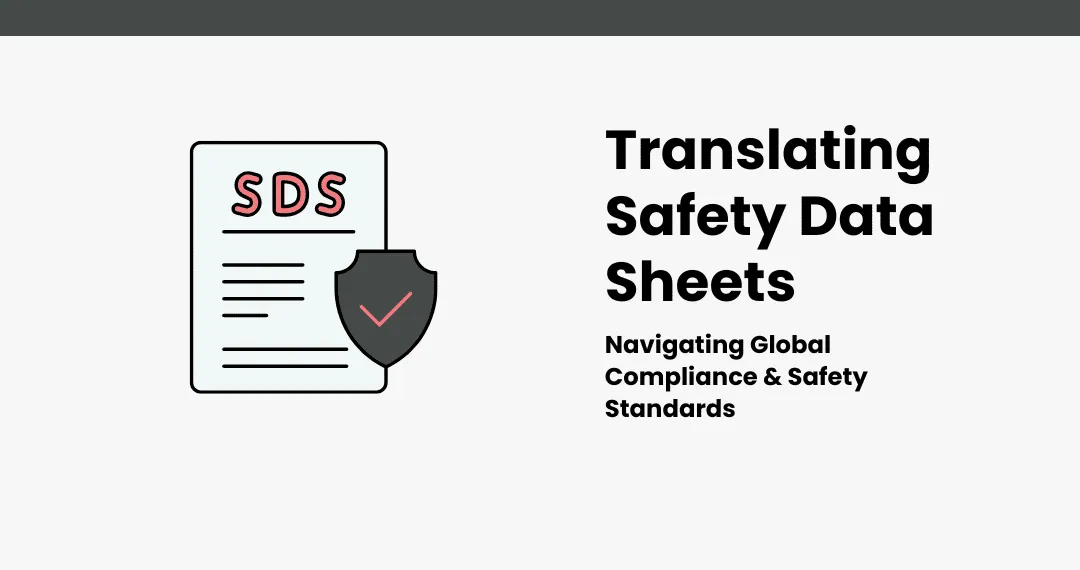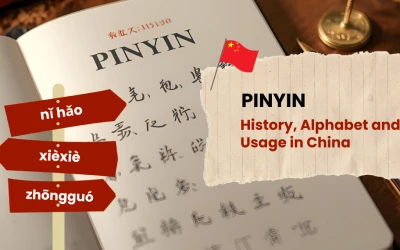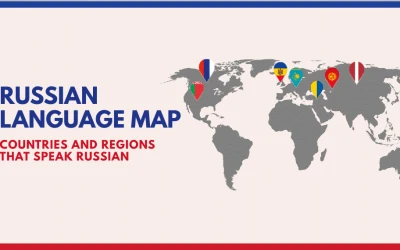Safety Data Sheets (SDS) or Material Safety Data Sheets (MSDS) are documents that are predominantly used in industries dealing with chemicals that can be potentially dangerous.
These documents contain critical information regarding the safety of the employees.
Thus, MSDS play a critical role in ensuring workplace safety as well as environmental protection.
MSDS and SDS are created to provide vital information about hazardous materials, possible risks, emergency measures, and handling procedures. They are especially common in chemical handling, production, or storage industries.
As businesses expand across borders, the importance of accurately translating safety data sheets cannot be overstated.
Proper SDS translation ensures that all employees, regardless of language and culture, understand the potential dangers and safety protocols associated with the substances they handle.
This blog explores the challenges inherent in Safety Data Sheets translation as well as the best practices to streamline the translation process, empowering businesses to effectively communicate safety information worldwide.
What are Safety Data Sheets?
(Material) Safety Data Sheets are vital documents that provide detailed information about hazardous substances and materials.
MSDS are common in industries dealing with chemicals, such as chemical manufacturing and processing, pharmaceuticals, healthcare and medical facilities, manufacturing and industrial production, construction and building materials, steel for infrastructure, agriculture and pesticides, textiles, and many more.
SDS serve as an essential resource for employers, employees, and emergency medical personnel and outline the properties of chemicals, potential hazards, safe handling, storage procedures, and emergency response measures.
Typically, MSDS contain critical information such as physical and chemical characteristics, toxicity information, and regulatory compliance details, which is then separated into standardized sections.
This standardized structure ensures easy access to necessary information in order to manage risk effectively.
MSDS help ensure workplace safety by informing personnel about the materials they may encounter, enabling them to implement appropriate safety measures.
In many industries, offering comprehensive SDS is not only a best practice but also a legal requirement. Thus, MSDS translation can be of critical importance to international companies.
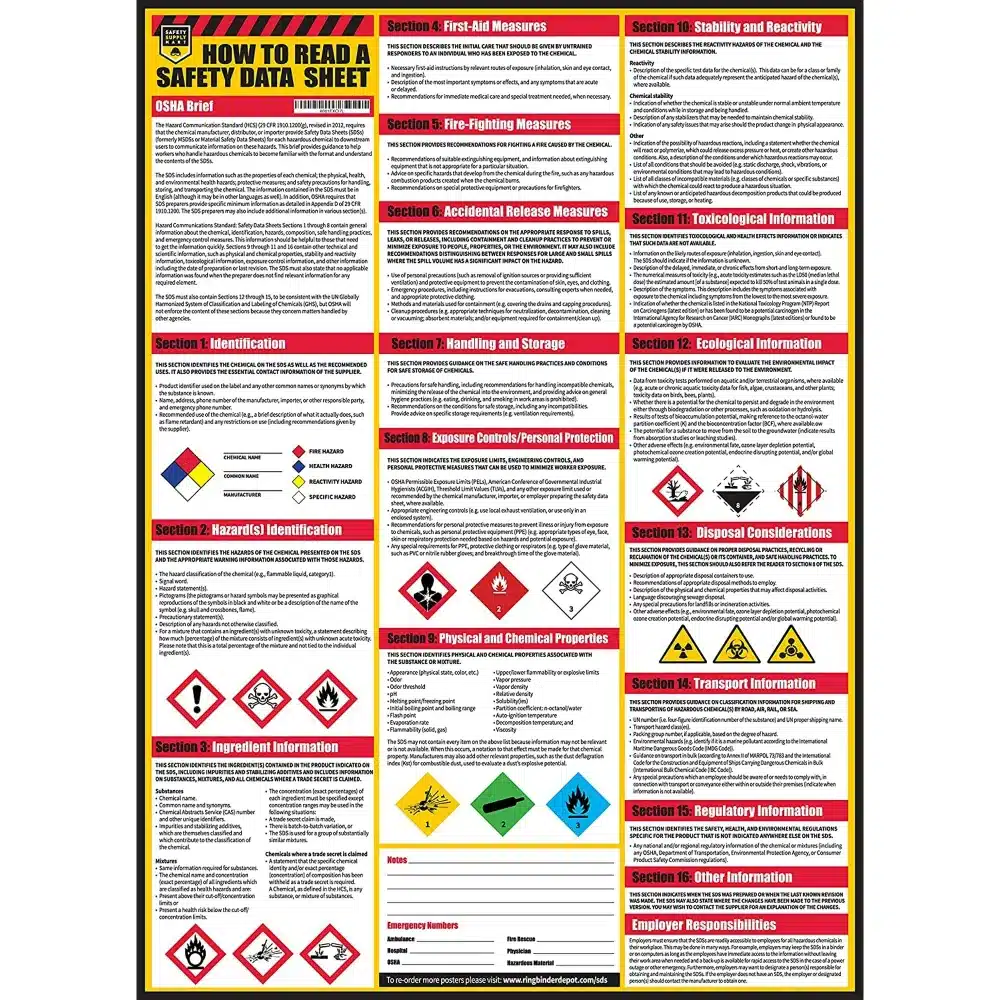
Importance of Safety Data Sheet Translation
Accurate MSDS translation ensures that vital safety information reaches all handlers, regardless of their native language and culture.
In most industries, offering accessible SDS is essential for maintaining a safe work environment, as it enables everyone to understand the hazards associated with chemicals they may handle.
Moreover, Safety Data Sheets translation might be a mandatory compliance, depending on the region a company is operating in. Providing SDS translations is the only way to comply with local regulations and standards, avoiding any possible legal penalties.
Needless to say, inconsistent or inaccurate translations can lead to misunderstandings that may result in accidents, injuries, or environmental damage.
Thus, companies should prioritize Safety Data Sheets translation in order to enhance workplace safety, fostering a culture of responsibility and compliance across international borders.
Global Compliance Frameworks for SDS
Navigating Safety Data Sheet translation projects requires a thorough understanding of various global regulations. These frameworks are essential for ensuring that safety information is communicated effectively and consistently across different languages.
Here are some of the most important global compliance frameworks for SDS:
1. OSHA Hazard Communication Standard (HCS)
In the United States, this standard requires that SDS must be provided for hazardous chemicals. This regulation aims to ensure that employees are informed about the risks.
2. GHS (Globally Harmonized System of Classification and Labeling of Chemicals)
Developed by the UN, GHS aims to standardize the classification and labeling of chemicals worldwide to ensure a more efficient and accessible information flow.
3. REACH (Registration, Evaluation, Authorisation and Restriction of Chemicals)
In the European Union, REACH mandates that companies provide comprehensive safety information for chemical substances, including SDS.
4. CLP (Classification, Labeling and Packaging Regulation)
CLP is another EU regulation that aligns with GHS and sets requirements for labeling and packaging hazardous substances.
5. WHMIS (Workplace Hazardous Materials Information System)
This Canadian system integrates GHS elements and requires employers to provide SDS for hazardous materials used in the workplace.
Understanding these frameworks is crucial for companies that operate on a global scale. Ensuring compliance not only protects the safety of employees but also mitigates legal risks associated with non-compliance.
Also read: CLP Regulation EC No 1272/2008: Translation Requirements
Language requirements for safety data sheets
Language requirements for SDS translations are key to ensuring that safety information is effectively communicated to all users.
Regulations often mandate that SDS must be available in the official language(s) of the country where the chemicals are distributed or used.
This ensures that all employees, regardless of their native language, have access to vital safety information in their working environment.
In many regions, such as the European Union and Canada, for instance, it is a legal requirement for companies to provide SDS in the language(s) understood by the workforce.
Additionally, companies operating in multilingual environments should consider translating safety data sheets into multiple languages to promote safety among their personnel.
Offering access to SDS translations not only helps prevent accidents but also fosters a culture of safety and awareness. SDS translation can be an empowering tool for international employees to make informed decisions about handling hazardous materials.
get your Safety Data Sheets translated by experts
Challenges faced in Safety data sheet translation
Safety Data Sheets translation presents several unique challenges that can impact accuracy and effectiveness.
Here are some key difficulties companies often encounter along their translation journey:
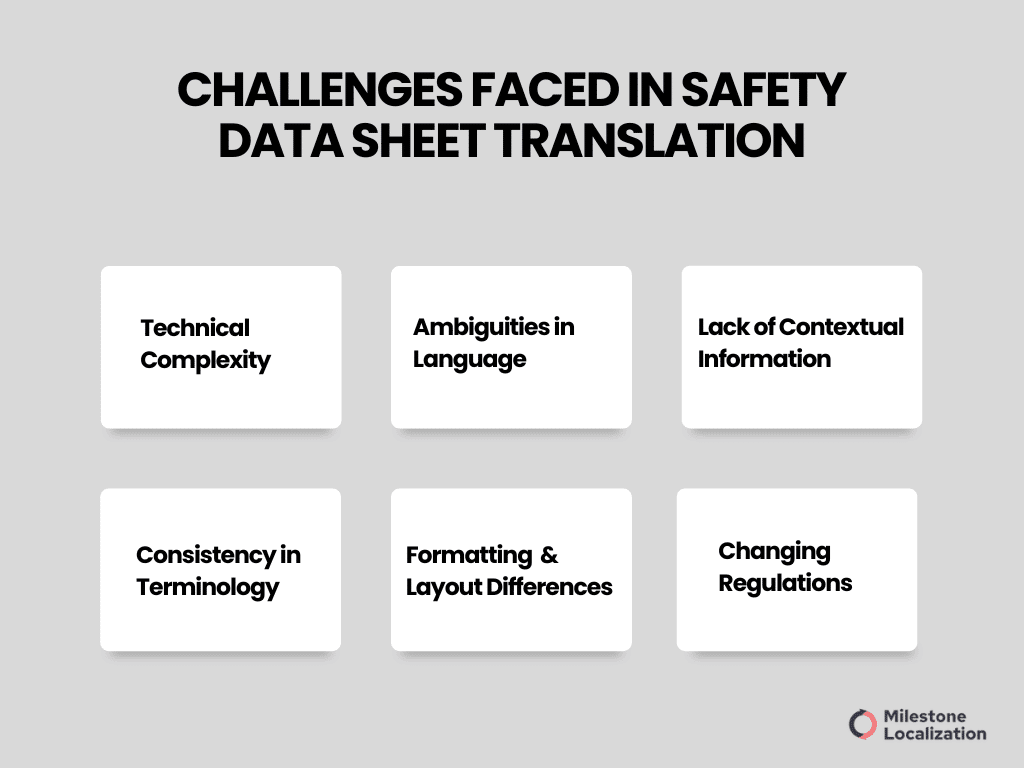
1. Technical Complexity
As most types of technical translation, SDS contain specialized terminology and complex concepts that require a deep understanding of both the subject matter and the target language.
Only a well-trained, professional translator can ensure that the final translation does not contain any ambiguities or mistranslations. Thus, opting for a professional chemical translation service provider is always a safe bet.
2. Ambiguities in Language
The inherent nuances and ambiguities of language can lead to misinterpretations, potentially compromising safety information in SDS.
Again, an excellent command of both working languages is required to guarantee precise final SDS translation.
3. Lack of Contextual Information
Often, translators may not have access to the specificities of the current MSDS project. Unfortunately, this can hinder the translation process and even result in ambiguities or mistakes in the final SDS translation.
In chemical translation services, companies are always advised to provide style guides, glossaries, or existing materials, such as brochures or previous translations.
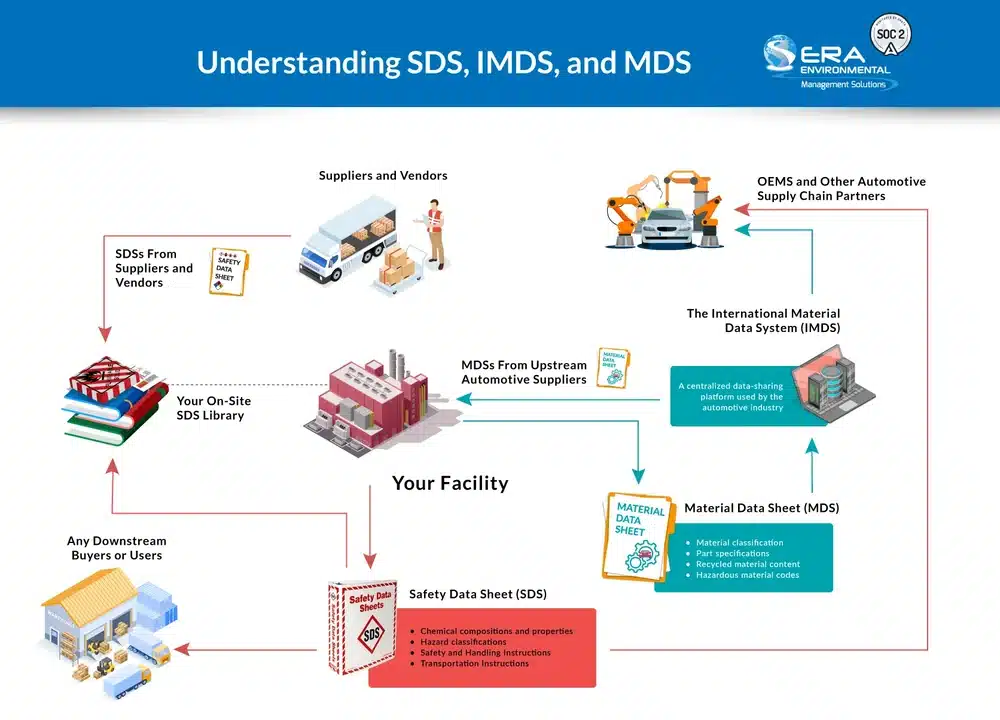
4. Consistency in Terminology
Maintaining consistent terminology across multiple languages is essential for clarity, but it can be challenging due to varying industry or company standards.
Professional SDS translation services providers employ a number of different strategies, such as creating glossaries, researching industry-specific terminology, collaboration with subject matter experts, and using translation memory tools, to ensure consistent terminology.
In chemical translation, such tools are incredibly beneficial to attaining high quality translations.
5. Formatting and Layout Differences
Different languages have unique formatting requirements, which can affect the readability and presentation of SDS.
Right-to-left languages, such as Hebrew and Arabic, for instance, pose formidable challenges for this type of chemical translation where format is strictly standardized.
What’s more, layout and formatting may vary across different regions/ countries, depending on regulations.
6. Changing Regulations
As the industry evolves and introduces new materials and processes, regulations need to be adapted accordingly in order to protect users.
While keeping up with all updates can be a challenge on its own, one also needs to keep in mind that any new changes affect already existing SDS translations, complicating compliance efforts.
Addressing these Safety Data Sheets translation challenges is vital for ensuring that safety information is accurately conveyed, ultimately protecting employees and the environment.
Best practices for safety data sheet translation
To ensure accurate and effective Safety Data Sheets translation, consider the following best practices:
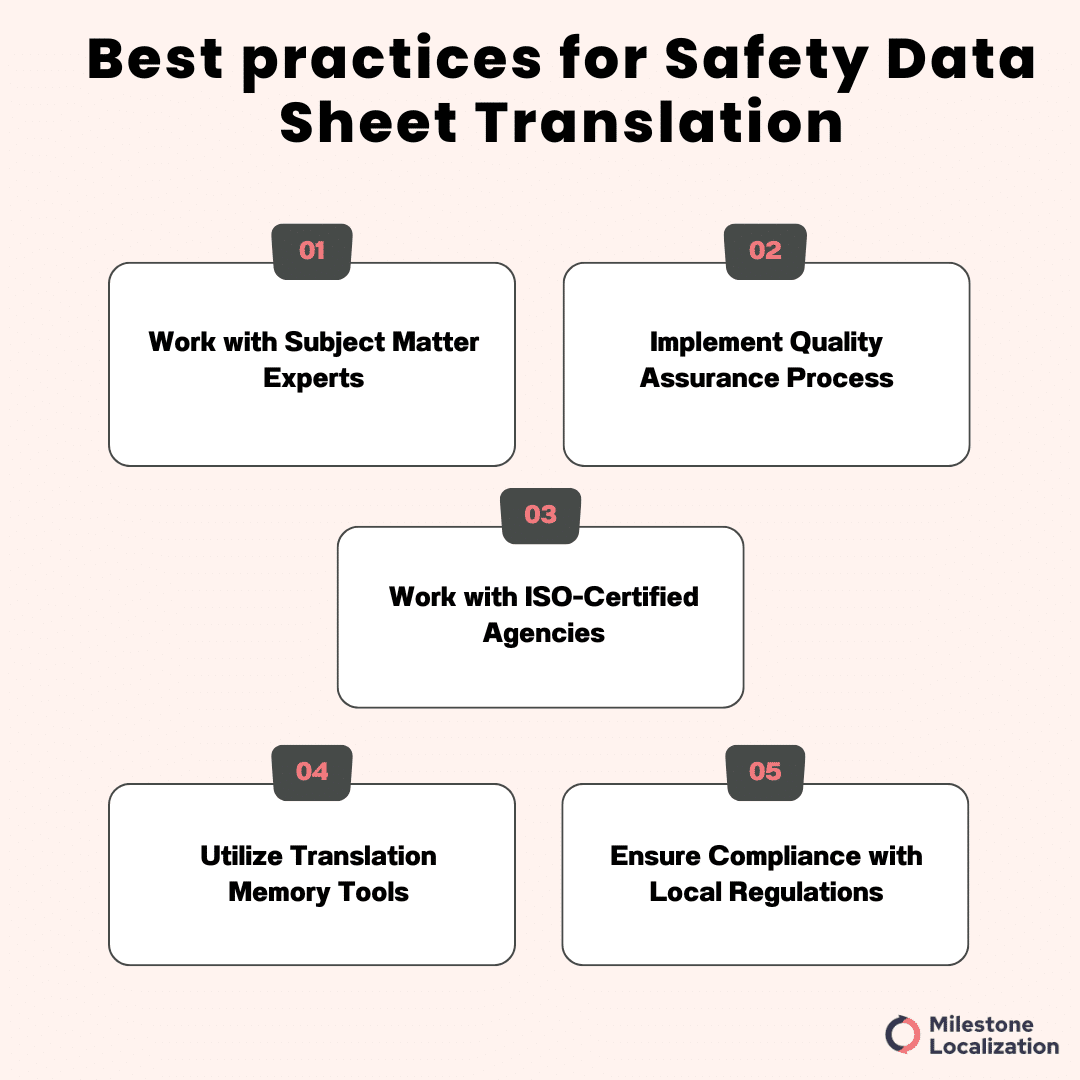
1. Work with Subject Matter Experts
Collaborating with subject matter experts in chemistry and regulatory compliance ensures that technical details are accurately conveyed in the target language.
While translators are doing the actual translation, subject matter experts’ responsibilities lie in ensuring that the translation is accurate and complies with the local industry standards.
In fact, subject matter expert review is a very common practice in the field of technical translation.
2. Implement Quality Assurance Process
Establishing a rigorous quality assurance process helps catch errors and inconsistencies, ensuring high-quality MSDS translation.
Depending on the project, the QA process might look differently, including different stages such as bilingual review, technical verification, feedback incorporation, or quality checks.
3. Work with ISO-Certified Agencies
Partnering with an ISO-certified chemical translation service provider guarantees adherence to international standards, enhancing the credibility and reliability of translations.
ISO standards cover many aspects of the translation process, such as level of language proficiency of translators, utilized software, confidentiality practices, ect. This in turn ensures high quality MSDS translation.
4. Utilize Translation Memory Tools
Translation Memory tools store previously translated segments, promoting consistency and efficiency across multiple projects.
What’s more, Translation Memory can be beneficial in the long-term, allowing you to reuse old translations for future projects and thus, reduce the overall costs.
MSDS documents can be long texts which in turn could result in high translation costs. Thus, it’s always advisable to utilize any available tools to reduce the overall costs of chemical translation projects.
5. Ensure Compliance with Local Regulations
Staying informed about local regulations ensures that your MSDS translation projects meet legal requirements, reducing the risk of non-compliance and associated penalties.
Implementing these practices can significantly enhance the quality and effectiveness of technical translation, promoting safety in the workplace.
Conclusion
In conclusion, translating Safety Data Sheets (SDS) is a critical component of workplace safety and compliance in a global marketplace.
By understanding the importance of accurate technical translation and adhering to best practices, companies can effectively communicate vital safety information across diverse languages and cultures.
Ultimately, a commitment to high-quality MSDS translation not only protects employees but also fosters a culture of safety and responsibility within organizations.
Looking for Technical translation services
FAQS
What is a Safety Data Sheet (SDS)?
A Safety Data Sheet (SDS) is a standardized document that provides essential information about the properties, hazards, safe handling, storage, and disposal of chemicals and substances.
Why is translating Safety Data Sheets important for global compliance?
Different countries have strict regulations on chemical labeling and safety documentation. Translating SDSs ensures compliance with local laws, prevents legal penalties, and promotes workplace safety.
Which languages are required for SDS translations?
The required language depends on the country where the product is sold or used. For example, the EU mandates SDSs in the official language(s) of each member state, while other regions have their own requirements.
Who is responsible for ensuring accurate SDS translations?
Manufacturers, importers, or distributors placing the chemical product on the market are responsible for providing accurate and compliant SDS translations.
How can professional translation services help with SDS compliance?
Specialized translation providers ensure technical accuracy, correct use of chemical terminology, and compliance with regulations such as OSHA, CLP, and REACH, minimizing risks for businesses and workers.
What are the risks of inaccurate SDS translations?
Errors in SDS translations can lead to safety hazards, employee accidents, regulatory fines, shipment delays, and even product recalls.

